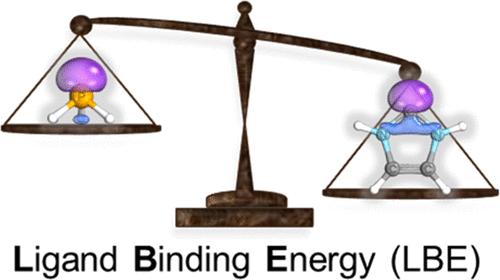当前位置:
X-MOL 学术
›
Inorg. Chem.
›
论文详情
Our official English website, www.x-mol.net, welcomes your
feedback! (Note: you will need to create a separate account there.)
Phosphine versus Carbene Metal Interactions: Bond Energies
Inorganic Chemistry ( IF 4.3 ) Pub Date : 2024-07-22 , DOI: 10.1021/acs.inorgchem.4c01796 Damian P Duda 1 , Kyle C Edwards 1 , David A Dixon 1
Inorganic Chemistry ( IF 4.3 ) Pub Date : 2024-07-22 , DOI: 10.1021/acs.inorgchem.4c01796 Damian P Duda 1 , Kyle C Edwards 1 , David A Dixon 1
Affiliation

|
A variety of different ground-state structures of carbene and phosphine groups 1 and 2 cationic, group 11 cationic, and group 10 neutral complexes were studied using density functional theory (DFT) and correlated molecular orbital theory (CCSD(T)) methods. Geometries of complexes with phosphines were studied and compared to available experimental data. Among the three analyzed phosphine ligands, PH3, PMe3, and PPh3, PH3 was found to have noticeably smaller ligand binding energies (LBEs, ΔH298 K). PPh3 has the greatest LBEs with group 2 dications. The difference in LBEs for PMe3 and PPh3 in complexes with group 1 monocations and transition-metal (TM) complexes was significantly less pronounced. The stability and reactivity of phosphine complexes were analyzed and compared with those of previously studied N-heterocyclic carbenes (NHC). PH3 has smaller LBEs compared to NHC carbenes. The lower LBEs correlate with the hardness for M(11)+ complexes and correlate with both the hardness and ionic radii for the M(1)+ and M(2)2+ complexes. The presence of additional PH3 substituents on the metal center makes the LBE smaller compared to their unsubstituted or less substituted analogs. The presence of NH3 in a structure causes a smaller effect on binding, and, except for carbene–PtNH3, an increase in LBE was observed. Composite-correlated molecular orbital theory (G3MP2) was used to predict the LBE of various Lewis acidic ligands with PH3 and NHCs to contrast their binding behavior. Binding either phosphine or carbene to metal diamine complexes caused ligand exchange and transfer of NH3 to an outer coordination sphere.
中文翻译:

膦与卡宾金属相互作用:键能
使用密度泛函理论 (DFT) 和相关分子轨道理论 (CCSD(T)) 方法研究了卡宾和膦第 1 族和第 2 族阳离子、第 11 族阳离子和第 10 族中性配合物的各种不同基态结构。研究了膦配合物的几何形状,并与现有的实验数据进行了比较。在所分析的三种膦配体PH 3 、PMe 3和PPh 3中,发现PH 3具有明显较小的配体结合能(LBE,Δ H 298 K )。 PPh 3在第 2 组适应症中具有最大的 LBE。第 1 族单阳离子配合物和过渡金属 (TM) 配合物中 PMe 3和 PPh 3的 LBE 差异明显不太明显。分析了膦配合物的稳定性和反应性,并与之前研究的 N-杂环卡宾 (NHC) 进行了比较。与 NHC 卡宾相比,PH 3的 LBE 更小。较低的 LBE 与 M(11) +配合物的硬度相关,并与 M(1) +和 M(2) 2+配合物的硬度和离子半径相关。与未取代或较少取代的类似物相比,金属中心上额外 PH 3取代基的存在使得 LBE 更小。结构中NH 3的存在对结合产生较小的影响,并且除了卡宾-PtNH 3之外,观察到LBE 的增加。复合相关分子轨道理论 (G3MP2) 用于预测各种路易斯酸性配体与 PH 3和 NHC 的 LBE,以对比它们的结合行为。 将膦或卡宾与金属二胺络合物结合引起配体交换并将NH 3转移至外部配位球。
更新日期:2024-07-22
中文翻译:

膦与卡宾金属相互作用:键能
使用密度泛函理论 (DFT) 和相关分子轨道理论 (CCSD(T)) 方法研究了卡宾和膦第 1 族和第 2 族阳离子、第 11 族阳离子和第 10 族中性配合物的各种不同基态结构。研究了膦配合物的几何形状,并与现有的实验数据进行了比较。在所分析的三种膦配体PH 3 、PMe 3和PPh 3中,发现PH 3具有明显较小的配体结合能(LBE,Δ H 298 K )。 PPh 3在第 2 组适应症中具有最大的 LBE。第 1 族单阳离子配合物和过渡金属 (TM) 配合物中 PMe 3和 PPh 3的 LBE 差异明显不太明显。分析了膦配合物的稳定性和反应性,并与之前研究的 N-杂环卡宾 (NHC) 进行了比较。与 NHC 卡宾相比,PH 3的 LBE 更小。较低的 LBE 与 M(11) +配合物的硬度相关,并与 M(1) +和 M(2) 2+配合物的硬度和离子半径相关。与未取代或较少取代的类似物相比,金属中心上额外 PH 3取代基的存在使得 LBE 更小。结构中NH 3的存在对结合产生较小的影响,并且除了卡宾-PtNH 3之外,观察到LBE 的增加。复合相关分子轨道理论 (G3MP2) 用于预测各种路易斯酸性配体与 PH 3和 NHC 的 LBE,以对比它们的结合行为。 将膦或卡宾与金属二胺络合物结合引起配体交换并将NH 3转移至外部配位球。











































 京公网安备 11010802027423号
京公网安备 11010802027423号